
Caladenia fuscata, commonly known as dusky fingers, is a plant in the orchid family Orchidaceae and is endemic to eastern and south-eastern Australia, including Tasmania. It is a small ground orchid found in eucalyptus woodland and which flowers in September and October.
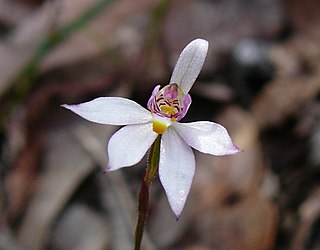
Caladenia alata, commonly known as the fairy orchid, is a plant in the orchid family Orchidaceae and is found in south-eastern Australia and New Zealand. It is a ground orchid with small, usually short-lived flowers, which have relatively stiffly held petals and sepals and reddish-purple bars on the labellum.

Caladenia amoena, commonly known as charming spider orchid, is a plant in the orchid family, Orchidaceae, and is endemic to Victoria, Australia. It is a ground orchid which grows singly or in small groups, has a single dark green, hairy leaf and a single yellowish-green flower with red stripes. It is only known from a few sites and has been classified as Endangered.

Caladenia ampla, commonly known as the dainty spider orchid, is a plant in the orchid family Orchidaceae and is endemic to Victoria. It is a ground orchid with a single hairy leaf and a single flower which is sometimes yellowish-green flower with red stripes and sometimes entirely red.
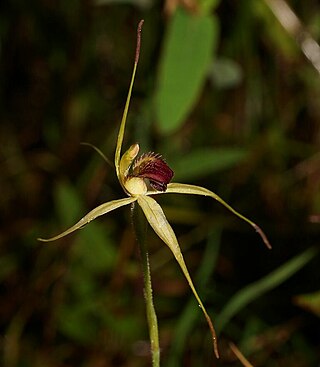
Caladenia ancylosa, commonly known as the Genoa spider orchid, is a plant in the orchid family Orchidaceae and is endemic to Victoria. It is a ground orchid with a single hairy leaf and a single cream-coloured flower with red markings.
Caladenia atradenia, commonly known as bronze fingers, is a plant in the orchid family Orchidaceae and is endemic to New Zealand. It is a ground orchid with a thin, hairy leaf and a thin wiry stem bearing one or two dark green or greenish red flowers with maroon or magenta markings.
Caladenia atrata, commonly known as dark caladenia is a plant in the orchid family Orchidaceae and is endemic to Tasmania. It is a ground orchid with flowers that are bright white on the front, but densely covered with black glands on the back.
Caladenia atrochila is a plant in the orchid family Orchidaceae and is endemic to Tasmania. It is a ground orchid with a single hairy leaf and flowers that are whitish or pinkish on the front, but yellowish-green on the back and a cream-coloured labellum with dark red markings.
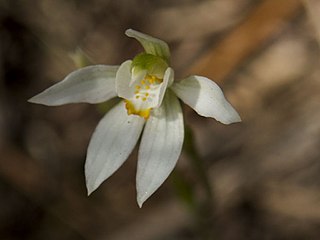
Caladenia aurantiaca, commonly known as orangetip fingers, is a plant in the orchid family Orchidaceae and is endemic to Victoria, although it is also found on one Bass Strait island. It is a slender ground orchid with a single hairy leaf and one or two short-lived, orange-tipped, white flowers on a thin, wiry spike.
Caladenia campbellii, commonly known as thickstem fairy fingers or thick-stem caladenia, is a plant in the orchid family Orchidaceae and is endemic to Tasmania. It is a ground orchid with a single, sparsely hairy leaf and one or two flowers that are pinkish on the outside and cream-coloured on the inside. The flowers are self-pollinating and short-lived.
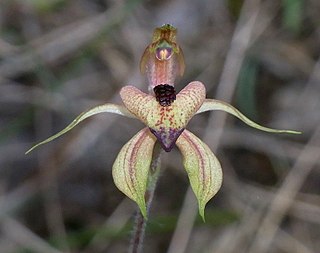
Caladenia cardiochila, commonly known as thick-lipped spider-orchid, fleshy-lipped caladenia and heartlip spider-orchid, is a plant in the orchid family Orchidaceae and is endemic to Victoria and South Australia. It is a ground orchid with a single hairy leaf and one or two yellowish-green, red-striped flowers on a thin, wiry stem.

Caladenia catenata, commonly known as white caladenia, white fingers and lady's fingers, is a plant in the orchid family Orchidaceae and is endemic to New South Wales, Queensland and Victoria. It is a ground orchid with a single hairy leaf and one or two white, sometimes pink flowers on a thin, sparsely-hairy stem. It is similar to Caladenia carnea but lacks the red and white bars on the labellum of that species.
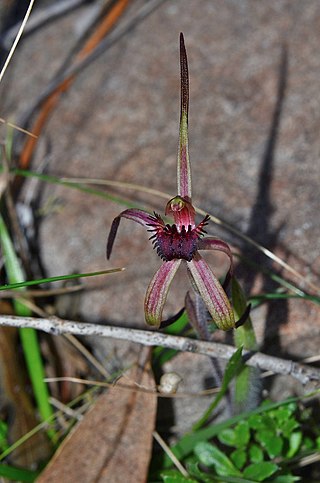
Caladenia caudata, commonly known as tailed spider orchid, is a plant in the orchid family Orchidaceae and is endemic to Tasmania. It is a ground orchid with a single hairy leaf and up to four red, or yellow and red flowers with dark red to almost black tips.
Caladenia cleistantha is a plant in the orchid family Orchidaceae and is endemic to the south-east of Australia. It is a ground orchid which occurs as solitary plants and has a singly hairy leaf and one or two cleistogamous flowers..
Caladenia coactilis, commonly known as thick fingers, is a plant in the orchid family Orchidaceae and is endemic to South Australia. It is a ground orchid which grows singly or in loose groups and has a single hairy leaf and one or two flowers which are bright pink inside and brownish on the back.

Caladenia conferta, commonly known as the crowded spider orchid or coast spider-orchid, is a plant in the orchid family Orchidaceae and is endemic to a restricted area in South Australia. It is a ground orchid with a single hairy leaf, and usually a single yellowish-green flower with red markings on a wiry, hairy stalk.
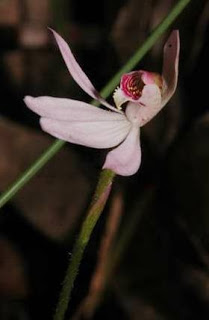
Caladenia curtisepala, commonly known as short-hooded fingers, is a plant in the orchid family Orchidaceae and is endemic to south-eastern Australia. It is a ground orchid with a single hairy leaf, and a single white to cream-coloured flower with a white labellum with red bands.
Caladenia dienema, commonly known as the windswept spider-orchid, is a plant in the orchid family Orchidaceae and is endemic to Tasmania. It is a ground orchid with a single, hairy leaf and a single, variably-coloured, usually dark red flower on a thin, wiry stem 5–12 cm (2–5 in) high.
Caladenia denticulata subsp. rubella, commonly known as the clumped spider orchid, is a plant in the orchid family Orchidaceae and is endemic to the south-west of Western Australia. It has a single erect, hairy leaf and one or two dull or pinkish red flowers with prominent dull red markings and with a white labellum with red markings.
Caladenia zephyra is a plant in the orchid family Orchidaceae and is endemic to South Australia. It is a ground orchid with a single, densely hairy leaf and a single cream-coloured to very pale yellow flower with blackish glandular hairs on the sepals and petals. It occurs on the Eyre Peninsula but may have a wider distribution.












